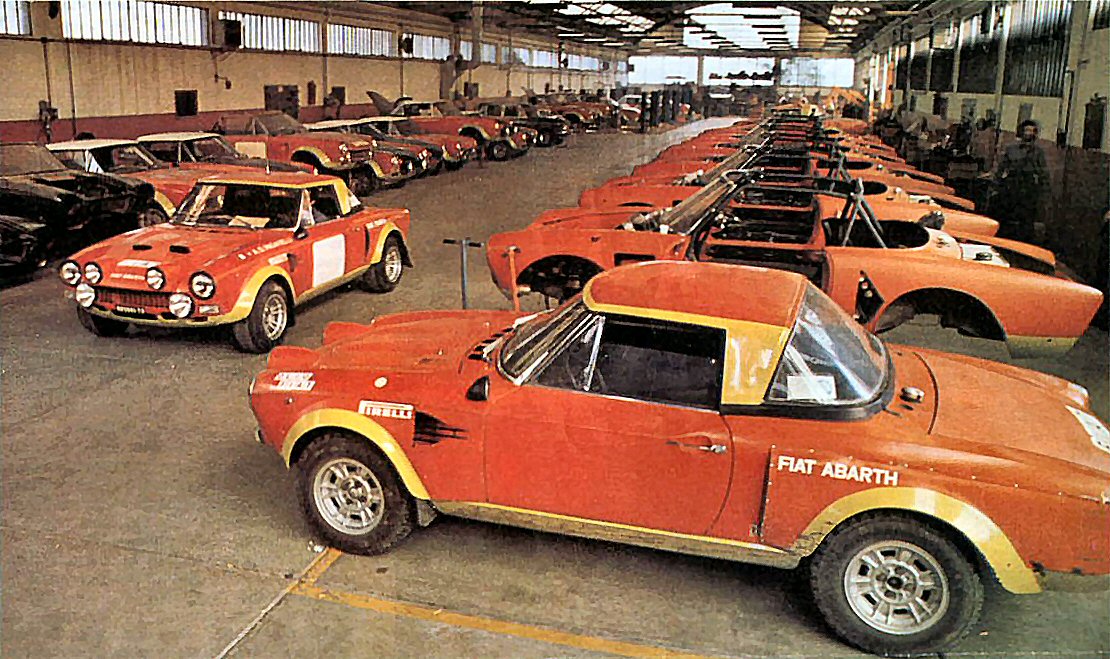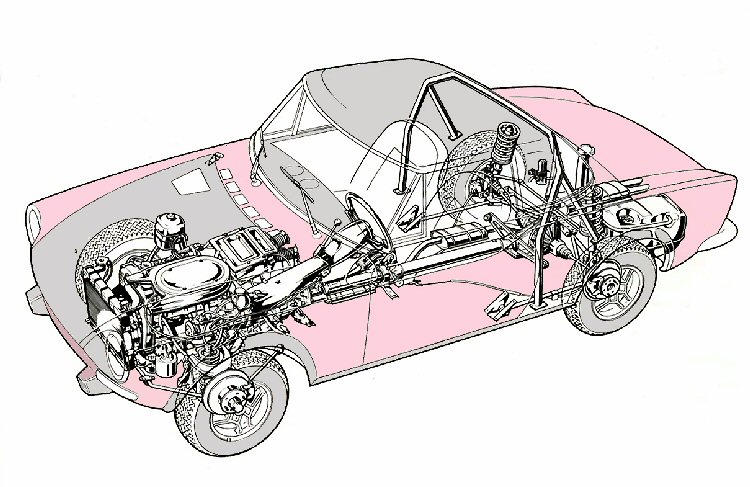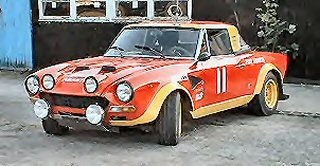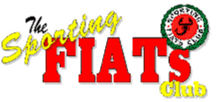Introducing
the 124 Spider Abarth
.
124
Spider Abarth History
Preparation
of the Works cars at Abarth tended to take place in batches of up to
ten cars, with several 124 Spider shells being pulled off the main production
line for preparation at Abarth's premises. Of the 400 road going cars
needed to qualify the 124 into the International Rallying Code for Group
4, Abarth would set aside about 30 or 40 shells for Works rally preparation.
The rest were prepared as road going versions (Stradale) for sale through
Fiat dealerships. The picture shows part of the works rally car preparation
for the final version of the 124 Abarth in 1975.

This year (1975)
also saw the introduction of the 16-valve head on the Works cars - at
the third attempt, and with Lampredi's personal involvement, the valve
inclination and valve seat re-design delivered both low and mid range
torque and a high power top end. Similarities between this chamber configuration
and the BDA Ford Cosworth have been noted.... and in addition Abarth
chose mechanical injection to deliver the fuel mixture..
History
of the 124 Abarth Rally
Pininfarina had exhibited a prototype version of the 124 Sport Spider
intended for rally competition at the 1972 Geneva Motor Show. It was
called the 124 Rally. Following on the success of the 1608cc cars in
Italian events, from 1969 the new ‘Rally’ took advantage
of the larger capacity 1756cc engines available from the Fiat 132 saloon
range.
It had been intended to launch a twin carb road version of the 124 Rally
that year but the oil crisis and resultant USA emissions regulations
affected plans. (The Weber IDF carb design intended for this project
found its way onto other cars – for instance the twin cammed Ford
Escort.
So
no twin carb.124 Sport Spider versions were made available and the pure
road going version of the 124 Spider Abarth was cancelled. We were left
with just 1000 of the 124 Abarth Rally’s produced to homologate
the car for Group 4 FISA regulations rally competition. (And some confusion
remains over the actual number produced).
The
two designs were quite different. Like other manufacturers, Fiat were
required by rally regulations to produce a large number of cars - with
many parts very similar to the actual works rally cars. The numbers
of cars required varied according to the class in which the rally car
was entered. The verification process is called homologation. The cancelled
twin carbed 124 Sport Spider design was basically a more powerful version
of the standard road going 124, plus Abarth badges.
The homologation 124 Abarths were produced at Abarth for two years from
1972… with special lightweight body panels, glass fibre boot and
bonnet, roll bar, minimal bumpers and alloy door skins. The mandatory
hard top was fitted with a perspex rear window and Abarth CD30 alloy
wheels plus Recaro bucket seats were installed. The 1800cc engine had
twin 44IDF carbs, the rear axle was fully independent with anti roll
bar. From 1973 a full performance package was available to take the
road car’s 128bhp basic output to 170bhp.
Summary
of the 124 Abarth Rally Developments - Homologation
It
starts with the second series BS Spider from 1970... with both the 1438
and 1608 engines in use. The papers date from the setting up of the
FIAT competitions department, supporting both the 125S and the 124BS
and cover the additional equipment. For verification purposes in today's
events, you are probably better off with a sales brochure, as homologation
was in its infancy then and details are difficult to understand.
Efforts
can be summarised into four stages....
1) In August 1971 Fiat purchased Abarth, and they (Abarth) homologated
the 1608 twin cam engine.... this is really also the first attempt to
describe the car in a homologation sense (and there were podiums taken
in the 1971 season by these cars, but they were not official works entries.)
2) The 1608 Spyder/ Spider is mainly defined & maintained for club
and national level rallying on papers from 71-72... then in 1972 there
is another attempt with some upgrades to make a full description of
the cars in mechanical terms... and adding items like a hard top. These
cars can be seen in International rallies up until 1976. Whereas the
original papers were prepared in Turin by Fiat employees, this second
set are produced by Abarth.
3) In 1971 Abarth develop a car aimed at winning the world rally championship
(the International Rally Championship 1970-73).... with five months
to prepare and homologate this car for the next season.
It had a full roll cage, 5 point independent rear suspension, hard top,
different twin carbs/ cams with 8v Abarth head, full sump guard, alluminium
light weight body panels, and shell strengthening. This resulted in
a package 22kg heavier than the standard car, and producing about 175bhp.
4) In 1974 the Spider Abarth homologation was changed to Group 3 (for
Production GT), this includes light weight wide arch panels and 8 inch
wheels, and light recesses in the bonnet. This is the year when the
production numbers of Stradale (Street versions) of the works cars was
finalised.... with different production numbers for different Groups
in the championship. These papers include a gearbox change to ZF over
Colotti gear sets. All the panels are thinner, and this represents the
biggest advance in the car... and the nearest they came to beating the
Stratos.
During the later part of the year, they uprated the car again, and entered
these changes into Group 4. This car has the 1840cc engine and 16v head,
with mechanical Kugelfischer injection producing 190bhp ready for the
1975 season. The wings have plastic extensions with air
intakes But these changes are dated from the 1975 season in the homologation
papers..
|
1972 Specifications |
124
Sport Spider 1600 |
124
Sport Spider 1800 |
124
Abarth Rally |
| Cylinders / cubic capacity |
4
in line |
4
in line |
4
in line |
| Bore x Stroke (mm) |
80
x 79.2 |
84
x 79.2 |
84
x 79.2 |
| Compression Ratio |
9.8:1 |
9.8:1 |
9.8:1 |
| Camshaft &
valve configuration |
|
|
|
| Induction |
Weber 34
DMS |
Weber 34
DMS |
Weber
44 IDF 20
Weber
44 IDF 21
|
| Max Power - bhp (DIN) @ rpm |
108
@6000 |
118
@6000 |
128
@6000 |
| Volumetric output (bhp/litre
DIN) |
67.8 |
67.2 |
72.9 |
| Max torque - m.kg
(ft/ibs) @ rpm |
14 (101.2)
@4,200 |
15.6 (112.8)
@4,000 |
16.2 (117.1)
@5,200 |
| Electrical
power - generator
- battery |
|
|
|
| Transmission -
gearbox, fwd |
|
|
5
speed |
| Transmission - gear ratios
fwd |
|
|
3.66,
2.10, 1.36, 1.0, 0.88 |
| Transmission -
clutch |
215mm
single dry plate
mechanical
diaphram |
215mm
single dry plate
mechanical
diaphram
|
215mm
single dry plate
mechanical
diaphram
|
| Transmission - differential |
Crown
wheel & Pinion |
Crown
wheel & Pinion |
Crown
wheel & Pinion |
| Top speed (mph) |
112 |
115 |
118 |
| Wheelbase (mm) |
2280 |
2280 |
2280 |
| Track
- Front (mm)
- Rear (mm) |
|
|
|
| Length
(mm)
Width
(mm)
Height
(mm) |
|
|
|
| Kerb Weight (kg) |
960 |
960 |
938 |
| |
|
|
|
124
Abarth Rallying Results
The team’s cars were winners of many events, including the European
Rally Championship, but the World Championship eluded them. This was
mainly due to another Fiat Group car… the magnificent Lancia Stratos!
The purpose-built Stratos simply overshadowed the rest of the semi-production
based designs like the 124 Abarth, heralding the future Group B rally
battles of the eighties.
The 124 Abarths were successful in winning events in 1974. The cars
seemed to be at their best on pace note events – where they could
be set up in advance of the corners – as WRC competitors do today.
The UK forest events at this time, including the RAC rally, were run
‘blind’ without the aid of pace notes. This type of event
puts at a premium on a flat torque curve and large suspension travel
– neither of which the Spider had. So the 124 Spider never did
very well in the UK events. The drivers also reported body flex and
'whip' on rougher gravel stages which can't have helped.
Without
the Stratos, 1975 would have been the title year for the 124 Abarth.
The last version of the competition cars built for the 1975 season also
had an Abarth produced 16-valve head with mechanical fuel injection
to boost competitiveness. More effort was focused on reducing body weight.
Unfortunately for the Fiat competition department, the 124 Rally lost
out to the Ferrari V6 engined Lancia Stratos (also produced within the
Fiat Group of course) as it swept all before it in the World Rally Championship
for a second season.
By 1976 Fiat had briefed Abarth to concentrate on 131 rally development
as their primary rally competition and marketing vehicle. Not before
some alternatives had been explored, such as the Prototipo 2000 X1/9
and a fundamentally re-designed 124 Abarth prototype.
The Monte Carlo Rally early in ’76 began the last season for the
last top-flight open topped rally car! (Try saying that sentence fast!)
The 131 Abarth (to achieve three titles in four years) then delivered
world championship success for Fiat.
124 Abarth Competition Specs
This information is provided as a general guide or starting point for
the cars concerned. Actual specs varied for events and as development
progressed. The road going versions could be ordered up to late 1974
from the factory.

1972
Spec for the Competition Cars:
Engine
132 AC4 000 Twin Cam belt driven
4 cylinder in line, 1756cc.
9.8:1 compression
84mm bore x 79.2mm stroke
8 valve head
Output 176bhp DIN @ 6000rpm (approx. -spec varied by event)
Carburation 2x Weber 44 IDF
Ignition Electronic
Gearbox 5 speed Colotti, clutch: single dry plate
Ratios 3.667, 2.1, 1.361, 1.0, 0.881
Final Drive 10/43 ratio (varied per event) Limited Slip Differential
Suspension Front: McPherson strut type, coil springs, with upper wishbone
lower arm, anti roll bar & angled tie rods
Rear: fully independent McPherson strut type with trailing arms &
lower radius arms
Brakes Front & Rear disc
Weight 970kg dry
Wheels/tyres 13ins x 6.5j Pirelli Tyres
1975 Spec for Competition Cars:

Engine 132 AC4 Twin Cam belt driven
4 cylinder in line, 1840cc.
10:1 compression
84mm bore x 83mm stroke
16 valve Abarth head
Output 190bhp DIN @ 5900rpm
Carburation Fuel Injection Kugelfischer (mechanical metering)
Ignition Electronic Marelli
Fuel Tank capacity 12.0 gals, electronic pump
Gearbox 5 speed ZF, clutch: single dry plate
Final Drive 10/43 ratio (varied per event) Limited Slip Differential
Suspension Front: McPherson strut type, coil springs, with upper wishbone
lower arm, anti roll bar & angled tie rods
Rear: fully independent McPherson strut type with trailing arms &
lower radius arms
Brakes Front: & rear disc
Weight 900kg dry
Wheels 13insx 8j Cromadora Pirelli Tyres
The
124 Abarth Stradale (Street) Version
In
show room form the 124 Abarth Rally was officially available from November
1972. The power increase over the standard 124 Spider was a small 10bhp
- being quoted at 128bhp DIN at 6000 rpm.
From
1974 an Abarth kit was available, comprising camshafts carburettors
and manifiold, to raise the road going 124 Abarth's output to 150bhp
- nearer to the rally spec 175bhp). These road cars did not have the
limited slip differential but retained the competition rear suspension.
The look of the 124 Abarth was changed dramatically with black glass
fibre bonnet and boot (plus aluminium door skins), black hard top (white
optional). While the interior was finished with a revised dash,
Recaro bucket seats, and a rear roll bar.
The
wheels used were Abarth CD30 alloys and the centre 4 spoke design of
these wheels was retained by Abarth for the much wider tyres used by
the Works cars.
In terms of sports driving, the Abarth rear suspension design makes
a big difference to the stradale over the spider. While the limited
rear differential affords an opportunity to experience the true tail-out
and accelerate posture of the seventies rally car. With later versions
of the 2 litre Works engines installed I don't think its an exageration
to say that a good proportion of the scene will be viewed through the
side windows if real progress is to be maintained. Never
the most solid of chassis, the angles taken up by each corner can sometimes
best be described as interesting. I must find some quotes from the works
drivers of the era.
.
SFC
Gallery
Stories
Mick’s ex - Jolly Club Car
Discovering the history of this car is a bit like researching medieval
history. It’s hard to tell fact from fiction. If you repeat a
fiction often enough it can be taken for fact.
The story is that my car, (chassis 0077244) was built up by Abarth in
1974 for the Works supported Jolly Club Rally Team. It was built to
full Group 4 spec alongside the works cars. Yet the chassis number is
late and out of sequence with the other batch numbers. This is consistent
with the story that it was built to special order.
The list of factory modifications to the car runs to about six sides
of A4, so I’ll omit it. Suffice to say the car was built to the
wide arch kit spec (although the brake ducts were later skimmed over)
full works suspension, steering brakes and electrics.
I’m confident it didn’t have the type 236b engine 16 valve
engine installed, as this would have required modifications not present
on the car. From 1976 on it could have run with a non-homologated 131
16 valve engine though. I have a photo of a works car in that spec.
I’ve also acquired parts of a type 236b 16-valve engine from Canada
with plans to build anew. The temptation gets stronger to wheel the
old battlewagon out in its proper environment again!
124
Abarth Links
Parts
• Suspension
bushes - Superflex offer a full range for both the 124 Spider and the
Abarth http://www.superflex.co.uk/SuperFlex_Fiat_124_Prices.pdf
• Deep in the
heart of Detmold Germany is part of the Holtmann Niedergerke Group.
For the Fiat 124 in particular they carry excellent stocks of new reconditioned
and second hand spares. They should be on your shopping list. H&N
Online Shop they are in the process of extending the online spares
list here. Local retail outlet is Gettingman & Niedergerke on +49
(0)5231/6179-0. Spares for 124s, all the Dinos and many earlier Fiats
are carried too.
• Retail outlets
for H&N products include Gettingman & Niedergerke a Detmold
Company (D 32758)
• Bielstein also
supply tuning and performance items for these cars. The Bielstein brothers
can still be seen occasionally 'pedaling' their race cars around - including
a 125! Bielstein products include very nice supportive reclining and
traditional seats that can be chosen to fit right into the 124s
www.bielstein.com
Their spares
are one of the reasons for the resurgence in 124 Spider ownership in
Germany too. However they are part of the Recambi Group - who are wholesale
suppliers. Recambi will probably only supply you direct with Abarth
and Volumex parts. You will need to find the Bielstein part of the organisation
- and the brothers who started this excellent business. Telephone +49
(0)5066/3074. Email bielstein@bielstein.com
Parts
and Advice
• In London
R Proietti Ltd and associated parts
and advice .
• Middle
Barton Garage at Chipping Norton near Oxford. Specialist with modifications
and Abarth parts galore. Very much in the Abarth tradition very capable.
Also do a large catalogue for the 124 range.
• Guy
Moerenhout 'does' Abarths in a big way. And his offerings are extensive!
• Fancy Spares
stockists of obsolete Fiat parts from the 50's to the 70's. Yetminster
in Dorset. 01935 872722.
• Trentside
Classics and Sportcars from their North Lincolnshire base, offer
a complete re-build service through their network of trades and craft
based businesses. Owner Mal has always had strong Fiat connections,
and usually has several projects around at any one time. Some of these
are even sane (then again some are very interesting!) Their experience
has been partly built on keeping Dinos on the road. Anything your 124
needs they can support.
• DTR
is one of the UKs leading advisors on the 124 and London based.
• Klaus Hermann
Mayer (automotive technology GmbH) one of their specialisms is supplying
hood and frames for many of the classic soft tops and cabriolets. Several
of the Fiats are listed including the 124 Spider http://www.cabrio.de/spider.htm
. They are not as easy to talk to in English direct. Check their
site Klaus Hermann Mayer and email
on khm@cabrio.de
• Spider-Point
have established a good reputation for advice and high quality parts.
Obtain a copy of their catalogue for the 124 Spider from the Spider
Point Site . TopDrive Gmbh - the company that runs Spider-Point
also has a weekly chat if your German's up to it. Also has large catalogue
of 124 Abarth parts.

